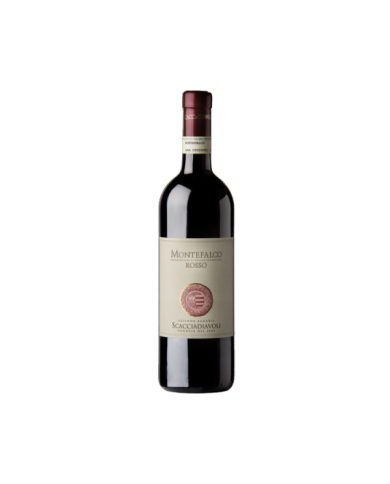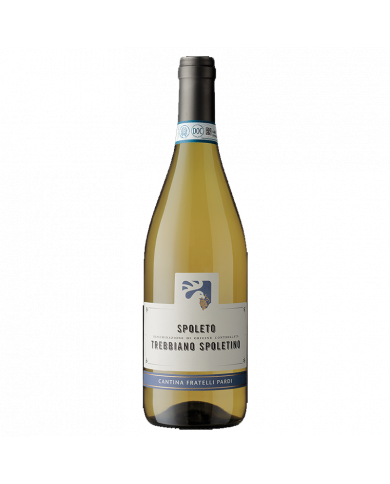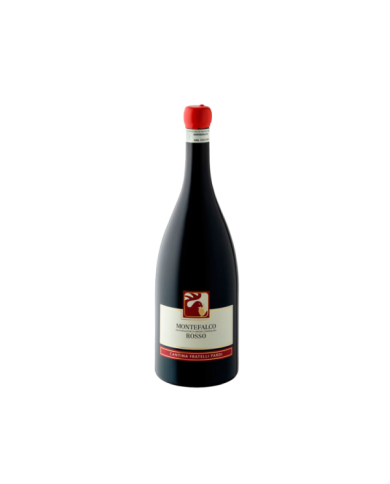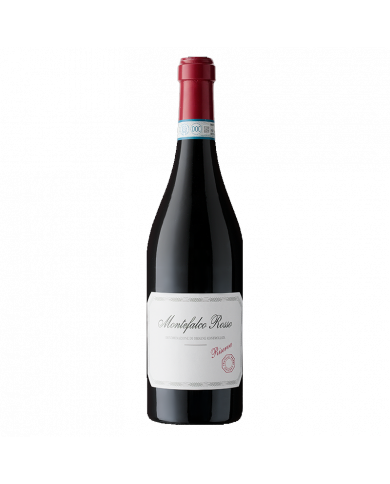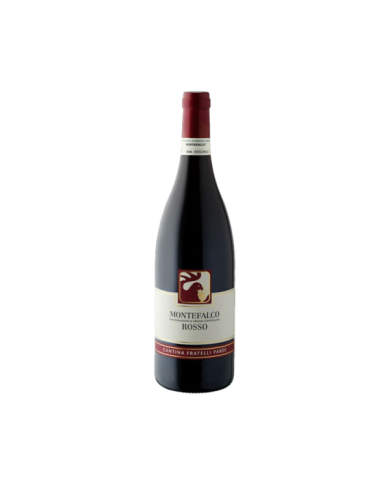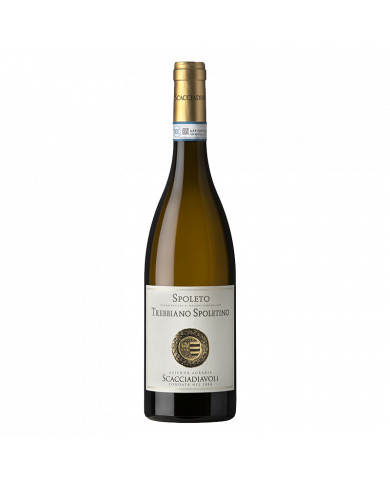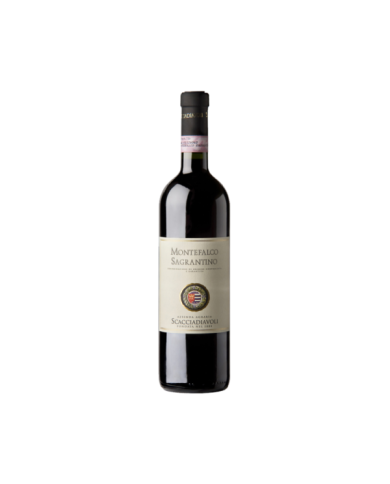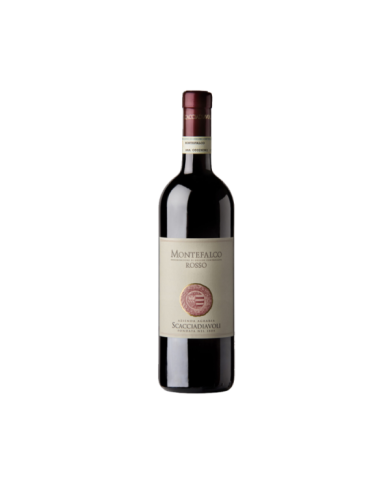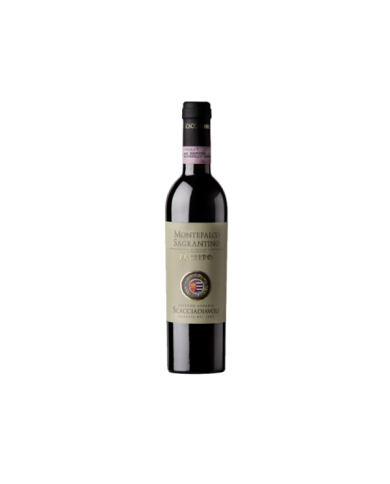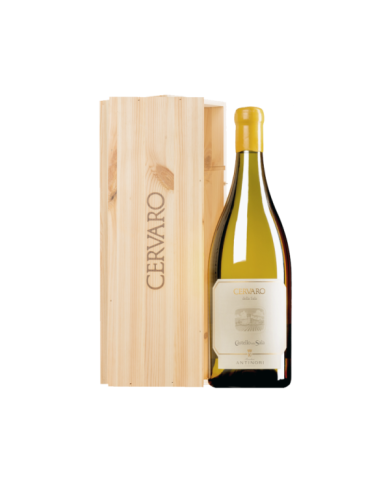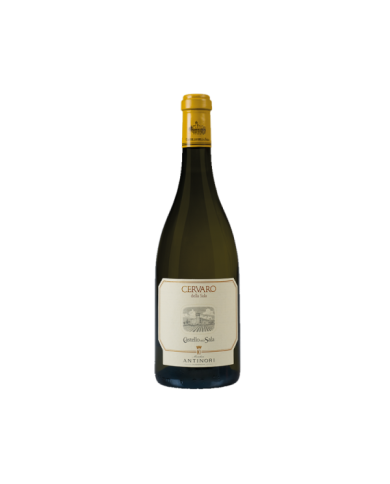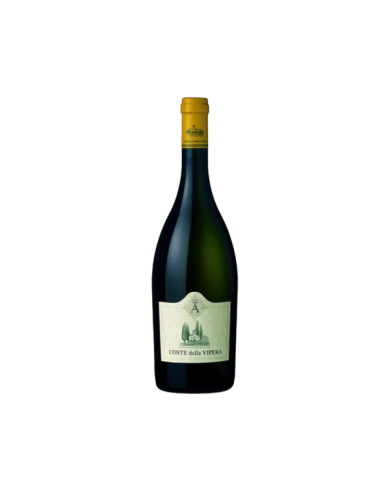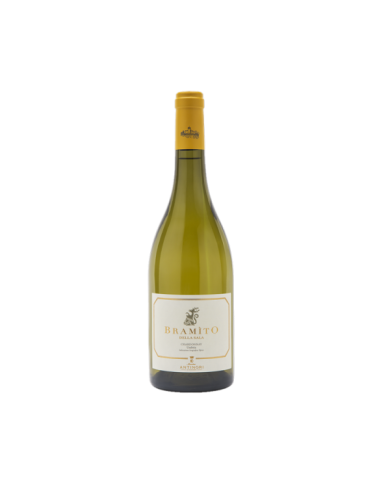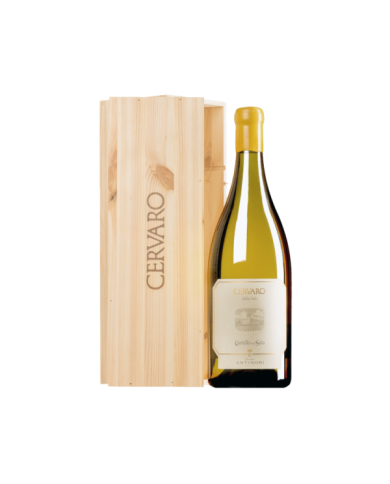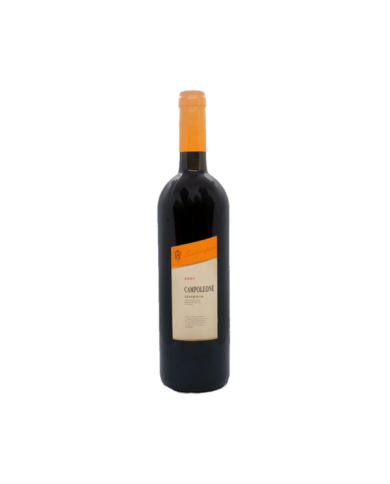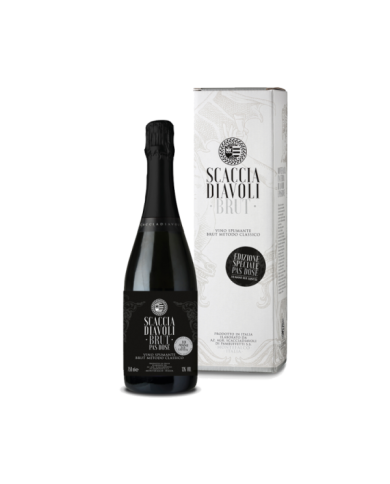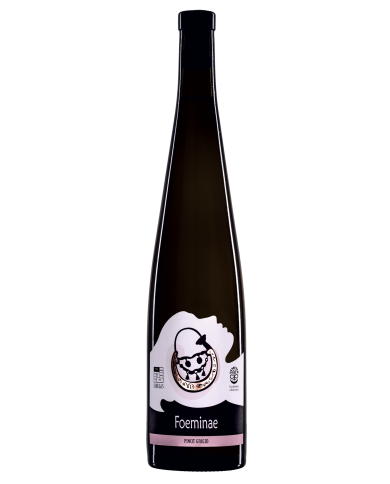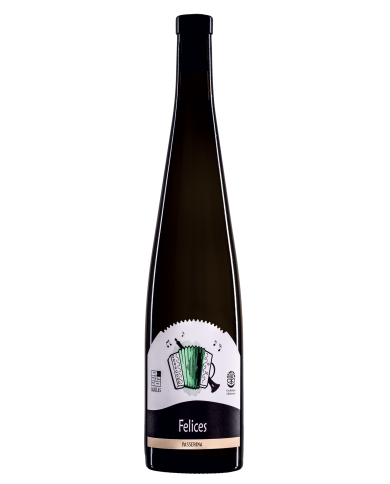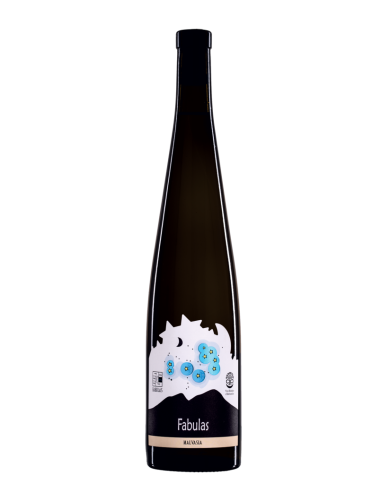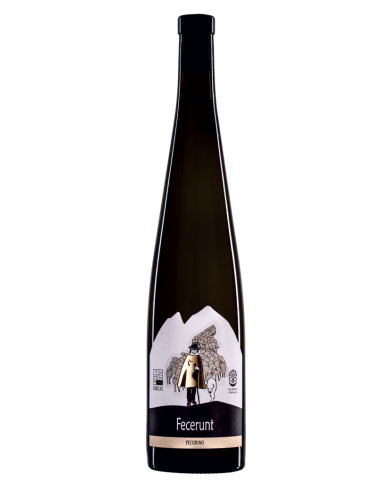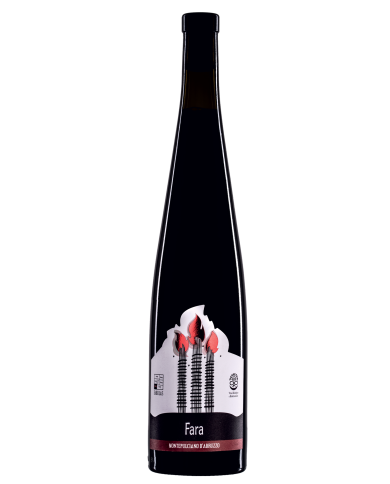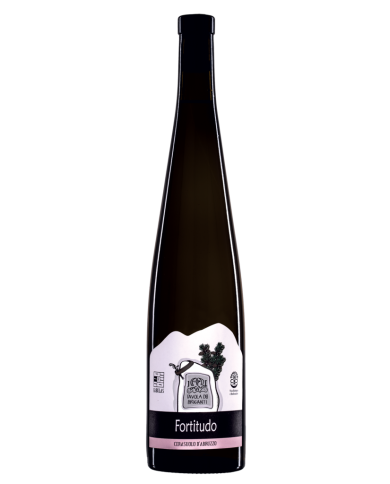Wine with an intense ruby color with nuances that turn towards garnet. The nose opens with the characteristic hints of wild strawberries and raspberry, strawberry and morello cherries, with a finish of sweet spices: vanilla, sweet pipe tobacco leaf and coffee. In the mouth we find it dry, the typical tannins of Sagrantino are modulated by the freshness and good alcohol content that make it a well-structured wine. Available in different sizes (from 0.75 up to 5 liters) and in special packs (min. Two bottles) or to be packaged for original gift ideas or unforgettable memories.
Riccardo I Umbria Rosso IGT wine from the La Veneranda winery . Wine with a characteristic intense ruby color. The nose releases all the essence of Sangiovese. It opens with hints of fresh red berry fruit: black cherry and cherry, to move on to wild fruit, such as strawberry and spices such as star anise and vanilla. In the mouth the fruit and carnality of Sangiovese are pleasant, modulated by the flavor and by a subtle and pleasant tannin.
Wine with an intense ruby color. This wine is the result of a perfect blend of three grape varieties: Sangiovese, Merlot and Sagrantino. The nose opens with a hint of red fruits, harmonized by the presence of Sagrantino which completes the tones with sensations of wild strawberry and raspberry. Wine with good structure and alcoholic strength, good freshness and flavor. Harmonious and well balanced wine.
Wine of excellent workmanship. Intense ruby red color, ample, elegant perfume with hints of cherry, soft and voluminous flavor. In the ancient tradition of the territory of Montefalco, after selecting the grapes for the production of Montefalco Sagrantino, all the other red varieties were harvested for the composition of a fresher and easy-to-match wine. Scacciadiavoli takes inspiration from this tradition and perfects it by adding that touch that makes this wine even more lovable.
Selection of the free-run juice with light pressure. Fermentation at temp. controlled (18 ┬░) followed by 8 months on the fine lees.
Fermentation at temp. constant (20 ┬░) for 20 days in stainless steel. The bottled wine remains for at least two months in the cellar.
Fermentation at temp. constant (20 ┬░) for 20 days in stainless steel. The bottled wine remains for at least two months in the cellar.
Alcoholic and malolactic fermentation in stainless steel.
Elevation in 26 hl French and Slovenian oak barrels for 18 months followed by 9 months in steel.
It dresses the glass in a beautiful deep ruby red. The nose is first set on dark fruit in jam and in alcohol, such as currants, black cherries and plums, then followed by intense references to green pepper, cocoa, rhubarb, licorice and chinotto. The mouth is extremely consistent with the nose, and is powerful but well managed in the tannic texture, warm, with excellent body and long persistence. Also ideal for the whole meal with the courses of the land cuisine, it is to be tried as an accompaniment to rabbit alla cacciatora.
Intense ruby red and full to the eye. The nose firstly gives deep notes of dark fruit, such as blackberries, sour cherries and black cherries, overripe and jam, then followed by references to eucalyptus, tamarind, cinnamon, myrtle and cocoa. The palate is all played between sweetness and tannins, to prove balanced, full-bodied and with a long persistence. Perfect with chocolate and excellent with fruit tarts, it is also ideal sipped alone as a meditation wine.
Montefalco Grechetto doc is a dry wine that presents a range of lively aromas on the nose as well as in the mouth. Sweet fruit, white and yellow flowers and a good acidic freshness keep it alive and persistent. A native white grape of Umbria, in Scacciadiavoli it is vinified in purity. It accompanies hot summer days served at the right temperature and goes well with first courses or light main courses all year round. Wine to drink young. The presence of deposits in the bottom of the bottle is natural.
That the Trebbiano Spoletino grape is of high enological interest is now a certain fact. It is an ancient vine that has only recently been rediscovered. It can be grown in the territory of Spoleto and Montefalco. In our cellar we have aimed to capture the finer and at the same time intriguing soul of this grape. We have given space to its changing and original aromas with a vinification in amphora that respects these characteristics and then we have strengthened its expressive character with an aging in untoasted wood and amphora for at least 9 months. In our opinion the result is that of a great white wine for aging, capable of surprising at every sip for its richness of facets.
The color is deep, the bouquet is sensual and the body is vigorous. Wine whose refinement is appreciated when young, when fruit and spices blend with the taste of wood, in which Sagrantino has been elevated. But it is after a few years that its success is fully appreciated, when balsamic notes intervene and the tannins soften: thus we discover a wine with a great personality. Montefalco Sagrantino DOCG is suitable for long aging: 20 and more years. Rich in polyphenols which have antioxidant and therefore beneficial properties. The presence of deposits in the bottom of the bottle is natural.
This sweet wine has a unique style. The red color is impenetrable, the scent evokes blackberries, dried fruit and cinnamon, the taste is of a singular balance. In fact, the dense texture of tannins imprisons acidity and sweetness and everything is confused, creating a gustatory sensation of harmonious fullness. It is thanks to the drying of Sagrantino grapes on racks that such a concentration is obtained. Originally Sagrantino grapes were used only for the making of this sweet wine, drunk on the occasion of religious ceremonies in the villages of the area.
Refined and intense, structured and persistent , it is obtained from Chardonnay grapes with a small percentage of Grechetto, a native grape that brings acidity and binds it even more to the territory. The vinification takes place in Allier and Troncaise barriques, where the wine then matures for six months before being bottled and left to refine for another 10 months.
Cervaro della Sala is clearly a white out of the box even in the tasting phase. At the sight it appears of a straw yellow with greenish hues. The nose is complex and broad: exotic fruit, citrus, and toasted notes of vanilla and butter deriving from aging in wood. In the mouth the important body is accompanied by a freshness and acidity that end in a long and persistent finish. A good white now and also in 15 years.
The Orvieto Classico Superiore San Giovanni della Sala di Antinori is born in vineyards located in the land surrounding the Castello della Sala, in Umbria. It is produced with Grechetto, Procanico, Pinot Bianco and Viognier grapes, harvested entirely by hand starting from the second week of September. Fermentation takes place separately by variety, with a part of the grapes subjected to a short cold maceration and the others pressed directly, in stainless steel tanks at a temperature of 16 ┬░ C. The wine ages on its lees for a few months in view of the subsequent assembly and bottling.
Castello della Sala's "Bramito della Sala" is a medium-bodied Chardonnay, soft and rich in aromas, aged for 5 months in barrique. Hints of fruit and vanilla are integrated with toasted and mineral nuances in a round, elegant and enveloping sip
The Muffato del Castello della Sala, one of the estates of the Marchesi Antinori , is a bright and persuasive sweet wine. On the nose it is a wine that reveals itself of great aromatic and gustatory intensity, with hints of candied fruit, honey, iodized and almost marine hints on a citrus hint. On the palate it is enveloping and the botrytizing process gives a sweet sensation well integrated into that of freshness that emerges after the sip
Dedicated to Donna Plautilla A. ancestor of our family who lived in the second half of the eighteenth century (1759-1809) and dedicated to all the women of Montefalco, the true guardians of the Sagrantino Passito tradition. The women were entrusted with the task of detaching the Sagrantino grapes from the stalks, the ŌĆ£sbacaturaŌĆØ for the subsequent vinification and it was a job that was done by the fire after dinner, in the cold evenings of late autumn. Images of true poetry for a wine that is itself poetry. The harvest of Sagrantino destined for drying takes place in the first days of October and is very meticulous. The clusters are treated with extreme care because they absolutely must not break, they are placed in small boxes whose bottom is covered with a layer of vine leaves (vine leaves). Only suitable bunches are harvested, those with the most sparse berries that can better withstand the long drying period on the ŌĆ£CamorcanneŌĆØ, racks where the bunches are placed side by side, without overlapping. The drying can last even more than two months, depending on the weather conditions. Once the right sugar content is reached, the vinification is the same as for other wines: temperature control, frequent pumping over, racking, soft pressing and racking. The final wine yield is very low, only 35% of the initial quantity of grapes. Unlike the Rosso and the dry Sagrantino it does not age in wood, but in steel barrels for a period of thirty-six months. Then follows the refinement in the bottle. The bottles produced are all numbered by hand.
Scimella is the ancient name of the land from which the grapes come, destined since ancient times to be a vineyard due to its particular position. The grape harvest to be allocated to ŌĆ£ScimellaŌĆØ DOC Montefalco Rosso is done in the last days of September or early October. They are harvested in the right proportions 60% Sangiovese, Merlot, 25% Cabernet Sauvignon and Barbera and 15% native grape variety. Harvested in 20Kg crates, the grapes are taken to the cellar and immediately pressed and left to ferment for about twelve / fifteen days, in steel barrels at a controlled temperature that never exceeds 25 ┬░ C. Once the fermentation is over, the phase of drawing off and pressing follows for the separation of the liquid from the skins. The wine thus passes into a steel barrel for the first decantation and after subsequent decanting, at the beginning of spring, it passes into a large French oak barrel until March of the following year. Put back in steel barrels, in the month of May, after eighteen months, it is ready to obtain its suitability to become the DOC Montefalco Rosso and to be bottled. Once in the bottle, "Scimella" refines for a further period of six months before being sold. Intense ruby red in color, it has a complex aroma, with hints of flowers, red fruit and spices. It goes well with structured first courses, tasty red and white meats. Serve at 18-20 ┬░ C
Wine with an intense ruby color. This wine is the result of a perfect blend of three grape varieties: Sangiovese, Merlot and Sagrantino. The nose opens with a hint of red fruits, harmonized by the presence of Sagrantino which completes the tones with sensations of wild strawberry and raspberry. Wine with good structure and alcoholic strength, with good freshness and flavor. Harmonious and well balanced wine.
Riccardo I Umbria Rosso IGT wine from the La Veneranda winery . Wine with a characteristic intense ruby color. The nose releases all the essence of Sangiovese. It opens with hints of fresh red berry fruit: black cherry and cherry, to move on to wild fruit, such as strawberry and spices such as star anise and vanilla. In the mouth the fruit and carnality of Sangiovese are pleasant, modulated by the flavor and by a subtle and pleasant tannin.
Obtained thanks to the drying process of Sagrantino grapes.
Very ample wine, with a great structure with a long aromatic persistence and a typical tannic finish supported by a pleasant sweetness.
Wine with great evolutionary capacities in the bottle. In fact, it can be refined in the bottle for many years, significantly improving.
Wine with an intense ruby color with nuances that turn towards garnet. The nose opens with the characteristic hints of wild strawberries and raspberry, strawberry and morello cherries, with a finish of sweet spices: vanilla, sweet pipe tobacco leaf and coffee. In the mouth we find it dry, the typical tannins of Sagrantino are modulated by the freshness and good alcohol content that make it a well-structured wine. Available in different sizes (from 0.75 up to 5 liters) and in special packs (min. Two bottles) or to be packaged for original gift ideas or unforgettable memories.
SPECIAL EDITION SPARKLING WINE CLASSIC METHOD BRUT PAS DOSE '- 10 YEARS ON YEASTS After more than 10 years of sur lies aging, our cellar offers a new sparkling wine with dosage zero. A special edition to celebrate our journey into the world of bubbles.
Discover the excellent wines of Umbria: taste the authenticity of a territory rich in history!
Umbria is an Italian region with a very ancient history, which extends between Lazio and the Marches, and its rural culture has been deeply marked by agriculture. For centuries, this region has produced wines of excellent quality, and it is still today one of the main centers of Italian wine production.
The excellent wines of Umbria are of great quality and can be tasted throughout the region. The best known varieties are Sagrantino, Grechetto, Canaiolo and Sangiovese, but there are also other local vines such as Montepulciano, Ciliegiolo, Cabernet Sauvignon and Merlot.
The wines produced in Umbria are of great quality, but also of great value: the wine production of the region is in fact recognized worldwide. There are many vines that have been planted in Umbria and which have adapted to the soils and climate of the region, which has made it possible to produce fine wines.
Discover the wine excellences of Umbria: tasting and history
The excellent wines of Umbria are a unique experience to discover. If you are passionate about wine, you cannot miss tasting the wines of the region: the flavours, aromas and sensations that can be savored during a tasting are truly unique, and will allow you to discover the most hidden secrets of Umbrian wine production.
To fully enjoy this area, you don't just have to taste the wines: one way to discover Umbria is also to visit the places where wine is produced. There are numerous Umbrian wineries and wineries that offer guided tours, where you can learn about the history and traditions of this land, discover its beauty and secrets, and taste the wines produced in the region.
The wine excellences of Umbria: the finest vines
Among the most appreciated wines of Umbria are Sagrantino, Grechetto, Canaiolo and Sangiovese. Sagrantino is a red grape variety of great value, which was declared a "superior quality wine" in 1992. It is a well-structured wine, with an intense ruby red color and spicy aromas, with notes of ripe fruit and hints of vanilla.
Grechetto is an aromatic white vine, with a straw yellow colour, intense and complex aromas with notes of exotic fruit, white flowers and peach. It is a medium-bodied wine with a fresh and pleasant flavour.
Canaiolo is a red grape variety that is used to produce various types of wines, from light and fresh to more structured and full-bodied ones. It is a very elegant wine, with an intense ruby red colour, fruity and spicy aromas, with notes of morello cherry and vanilla.
Sangiovese is a red grape variety originally from Tuscany, but which is also grown in Umbria. It is a wine of great structure, with an intense ruby red color and spicy aromas, with notes of ripe fruit and hints of vanilla.
The wine excellences of Umbria: to conclude
The excellent wines of Umbria are truly unique: no other wine in the world is able to express the history and traditions of a territory in such an authentic way. Tasting an Umbrian wine is a unique experience, which will allow you to discover the most hidden secrets of the region's wine production, and to savor the authenticity of a territory rich in history.
Wines of Umbria
Umbria is an Italian region known for its breathtaking landscapes, its art and its food and wine culture. Some of the finest wines of central Italy are produced here, thanks to the geographical position of the region and the particular climatic conditions. In this article, we will explore the wines of Umbria, their characteristics and their curiosities.
Umbria is located in the heart of Italy and borders Tuscany, Lazio and the Marches. The region is characterized by hills, valleys and mountains, which offer a unique environment for the production of high quality wines. The production of wine in Umbria dates back to Etruscan times, when the first vineyards were cultivated in the area.
History of wine production in Umbria
The production of wine in Umbria has a long tradition that dates back to Etruscan times. Over the centuries, winemaking has been influenced by many different cultures, including Roman and medieval. This has resulted in the production of a variety of unique wines, which have gained an international reputation.
Characteristics of Umbrian wines
The wines of Umbria are known for their elegance, their acidity and their balance. The grape varieties grown in the region are mainly red, such as Sagrantino, Sangiovese and Merlot. However, white grapes such as Grechetto, Trebbiano and Chardonnay are also very popular.
The best wines of Umbria
One of the most famous wines of Umbria is Sagrantino di Montefalco, a dry red wine with an intense flavor and a deep ruby colour. Torgiano Rosso Riserva, obtained from the blend of Sangiovese, Canaiolo and Cabernet Sauvignon grapes, is another fine wine of the region. As for white wines, Grechetto di Todi is one of the best, with a fruity flavor and pleasant acidity.
The production of wine in Umbria
The production of wine in Umbria is a very careful and scrupulous process. The region has many wineries, large and small, who work with passion to produce the best wines. Many of these wineries are family-run and use traditional production techniques.
Soils and climatic conditions
The Umbria region is characterized by a Mediterranean climate, with hot summers and mild winters. The soils are mainly clayey and rich in minerals, which favors the production of high quality wines. Furthermore, the altitude of the vineyards and the proximity to the Tiber river create microclimates which influence the ripening of the grapes and the flavor of the wines.
The designations of origin of Umbrian wines
The wines of Umbria are protected by various denominations of origin, including Torgiano DOC, Montefalco DOCG and Colli del Trasimeno DOC. These denominations guarantee the quality and origin of the wines, and represent an important promotional tool for the region.
The food-wine pairing
The wines of Umbria go perfectly with the local cuisine, which is influenced by the traditions of Italy and nearby Tuscany. White wines go well with fish-based dishes, fresh cheeses and vegetable-based first courses. The red wines go well with red meat, wild boar and game dishes.
Curiosities about the wines of Umbria
The wines of Umbria are full of interesting curiosities. For example, Sagrantino di Montefalco has been described by the famous sommelier Luca Gardini as "one of the best red wines in the world". Furthermore, Torgiano Rosso Riserva was the first Italian wine to obtain DOCG recognition.
Map
The wines of Umbria represent a heritage of great value for Italy. The region offers a great variety of fine wines, thanks to its geographical position and particular climatic conditions. The production of wine is a careful and scrupulous process, which involves many family-run wineries. The wines of Umbria go perfectly with the local cuisine and are an excellent choice for those who want to discover the authentic flavors of the region.
FAQs
What are the main grape varieties grown in Umbria?
The main grape varieties grown in Umbria are Sagrantino, Sangiovese, Merlot, Grechetto, Trebbiano and Chardonnay.
What are the best wines of Umbria?
The best wines of Umbria are Sagrantino di Montefalco, Torgiano Rosso Riserva and Grechetto di Todi.
What are the designations of origin of Umbrian wines?
The designations of origin of Umbrian wines are Torgiano DOC, Montefalco DOCG and Colli del Trasimeno DOC.
How do Umbrian wines pair with food?
White wines go well with fish-based dishes, fresh cheeses and vegetable-based first courses, while red wines go well with red meat, wild boar and game dishes.
What are the curiosities about the wines of Umbria?
Among the curiosities about the wines of Umbria, we find that Sagrantino di Montefalco has been described as one of the best red wines in the world by the famous sommelier Luca Gardini and that Torgiano Rosso Riserva was the first Italian wine to obtain DOCG recognition.







